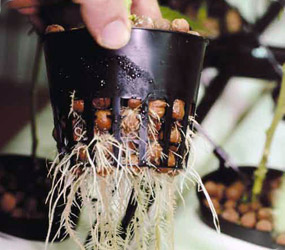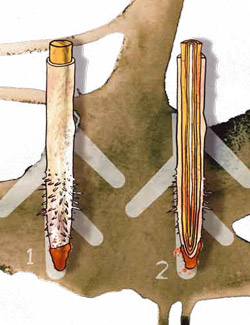The Plumeria Root System
The plumeria root system constitutes a major part of the plant body, both in terms of function and bulk. In plumeria, the root system is the subterranean or underground part of the plant body. Roots are branching organs which grow downward into the soil, a manifestation of geotropism. Branching occurs irregularly and not from nodes as in stems.
In contrast to shoot, the plant root has no leaves, nodes, internodes and buds. With rare exception, roots also lack stomata.
Other morphological and anatomical features which are distinct to this plant structure are:
- a hard, protective root cap at the tip of the root; (2) absence of the pith;
- presence of endodermis; and
- presence of pericycle next to the endodermis.
These features are found in the root apex which is divided into three regions:
- a region of cell division which includes the apical meristem protected by the root cap,
- a short region of cell elongation where individual cells elongate and force the root tip to move forward through the soil, and
- a region of cell differentiation and maturation.
In general, the plumeria root system either consists of a taproot system (with primary root found on seedlings) or fibrous roots (adventitious roots found on cuttings) with attached branch roots and finer rootlets having root hairs close to the tip.
Functions of the Plumeria Roots
Despite being inconspicuous because they are normally hidden underground, the plant root system performs various functions which are essential to growth and development. The extent of underground expansion of this plant structure serves as limitation in the growth of the plant. Thus potted plants usually exhibit slow growth but once the roots leak out from the bottom of the pot and penetrate into the ground, growth rate accelerates.
The functions of the plumeria root system include:
- Anchorage and support. The plumeria root system anchors the plant body to the soil and provides physical support. In general, however, taproot system provides more effective anchorage such that they are more resistant to toppling during storms.
- Absorption and conduction. The plumeria root system absorbs water, oxygen and nutrients from the soil in mineral solution, mainly through the root hairs. They are capable of absorbing inorganic nutrients in solution even against concentration gradient. From the root, these are moved upward. Plants with a fibrous root system are more efficient in absorption from shallow sources.
- Storage. The root serves as storage organ for water and carbohydrates. Fibrous roots generally store less starch than taproots.
- Reproduction. Plumeria do not reproduce from their roots.
 As mentioned, the root system will only increase in volume for as long as the rest of the plant continues to grow. However, transpiration from the leaves can also cause more roots to form in order to pump up the water needed. In the end, an equilibrium is established between the roots and the plant. A general rule of thumb is that the root system should comprise 30% of the total plant volume. Although this rule applies fairly consistently to plants in the open air, in substrate culture this does not always have to be the case. You can grow large plants in small pots as long as you supply them with water and nutrients and do not allow the pot to get too dry or too wet. To reduce the chance of this happening, we advise a large medium volume.
As mentioned, the root system will only increase in volume for as long as the rest of the plant continues to grow. However, transpiration from the leaves can also cause more roots to form in order to pump up the water needed. In the end, an equilibrium is established between the roots and the plant. A general rule of thumb is that the root system should comprise 30% of the total plant volume. Although this rule applies fairly consistently to plants in the open air, in substrate culture this does not always have to be the case. You can grow large plants in small pots as long as you supply them with water and nutrients and do not allow the pot to get too dry or too wet. To reduce the chance of this happening, we advise a large medium volume.